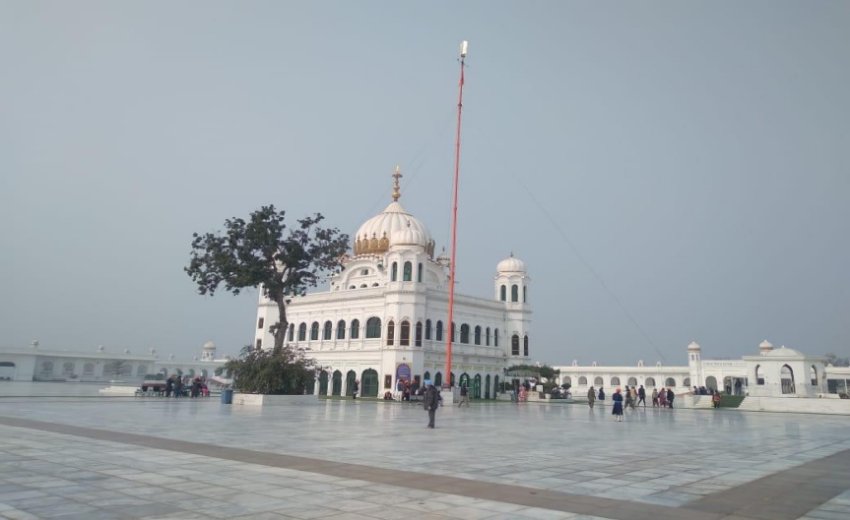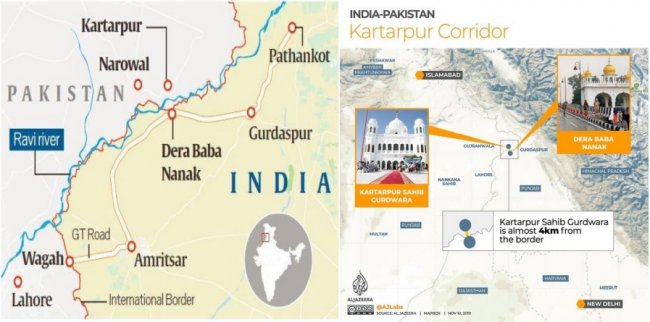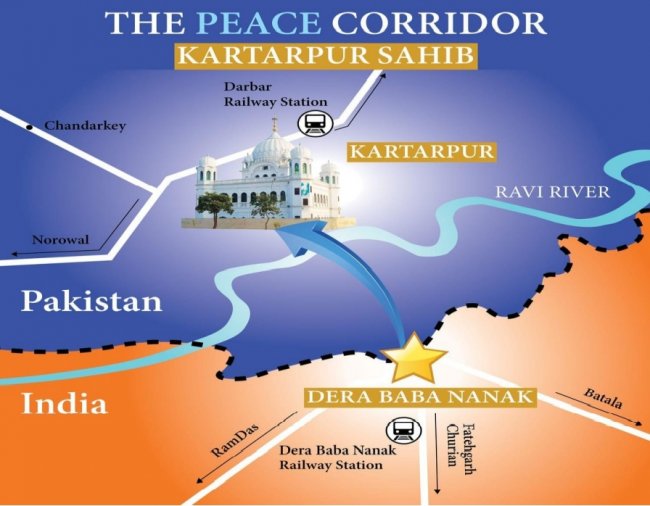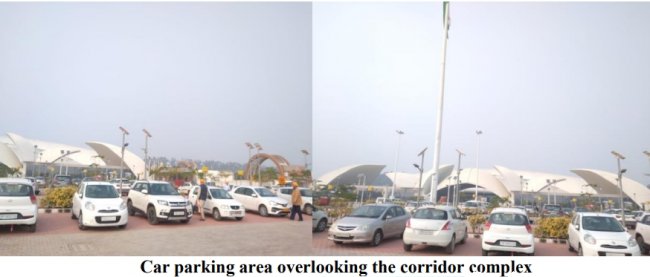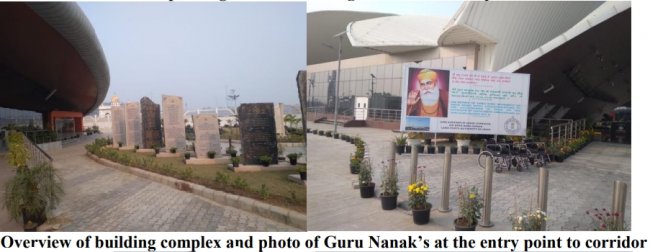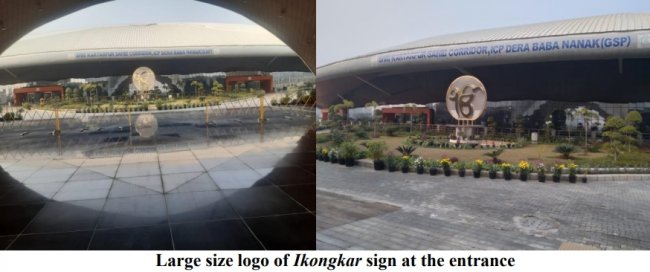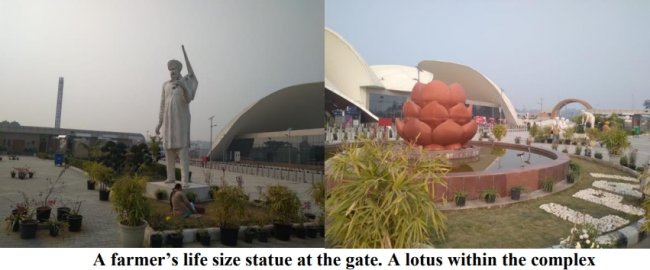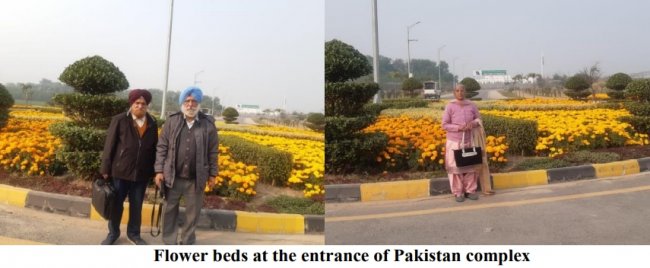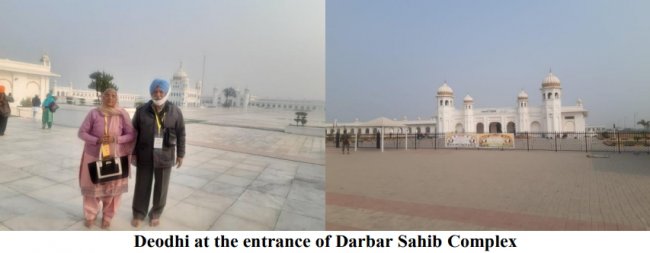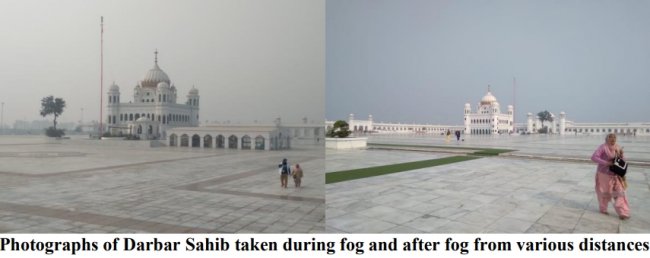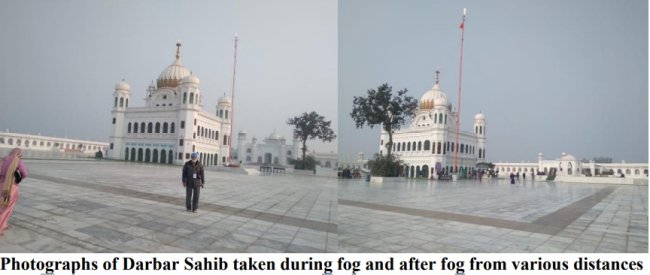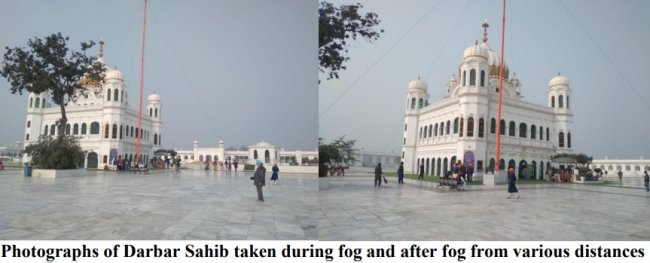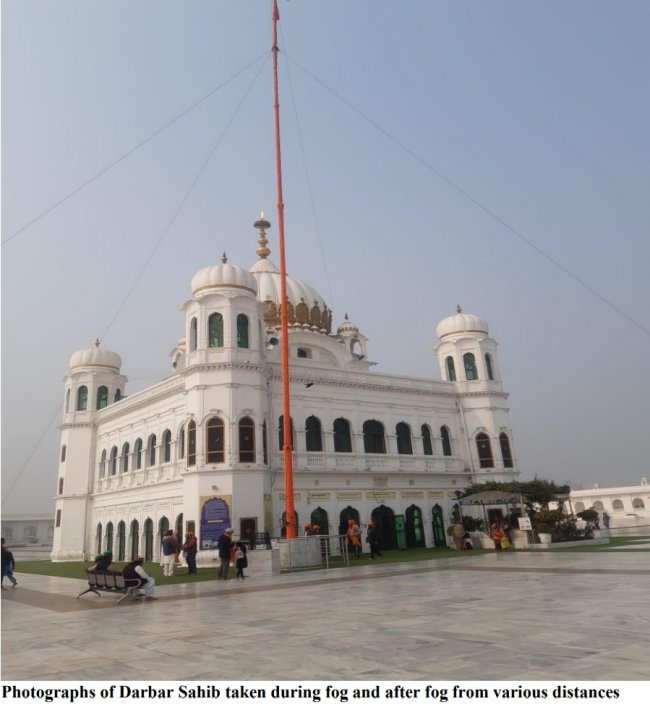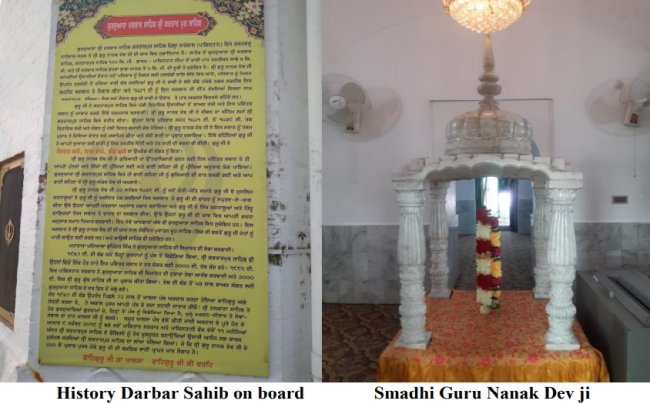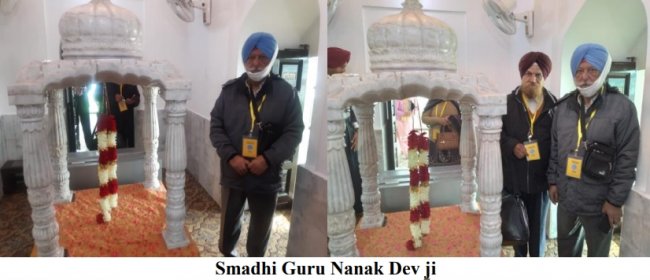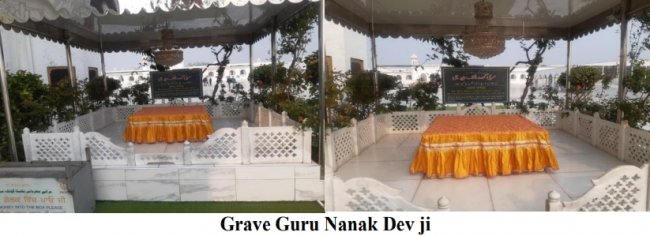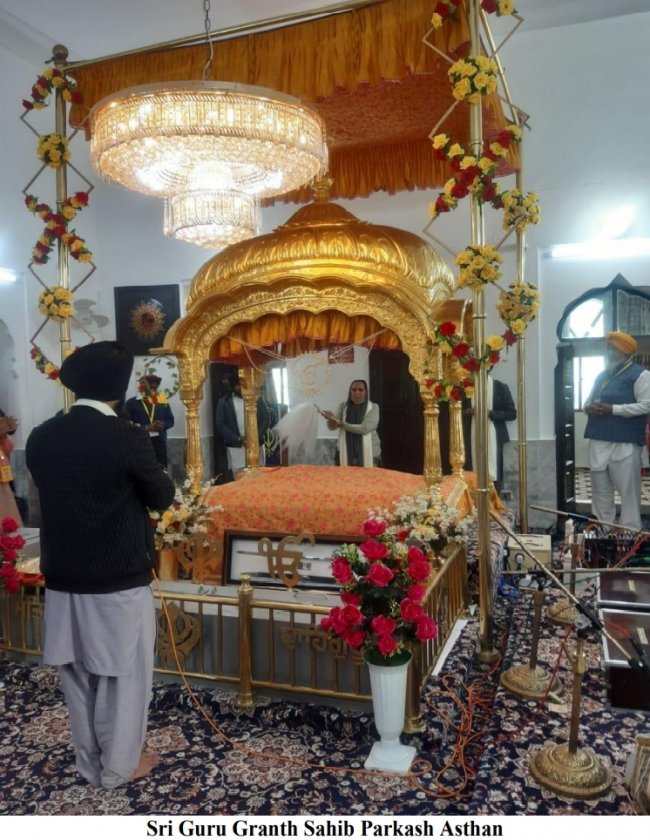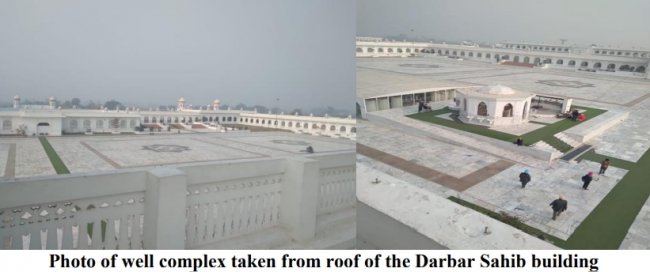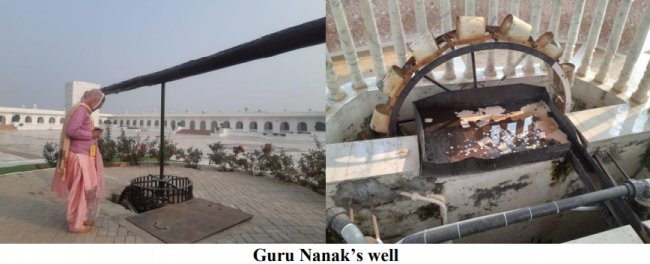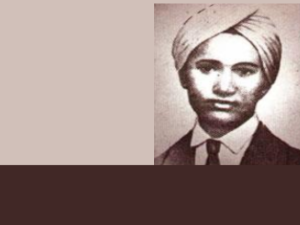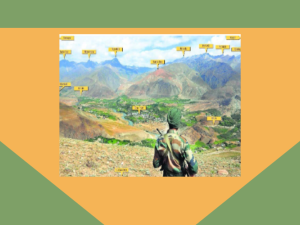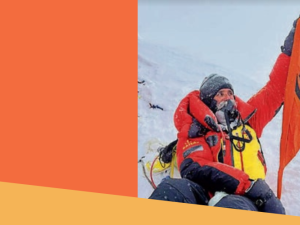Visiting Kartarpur Through Corridor Dr Dalvinder Singh Grewal I had visited Kartarpur earlier in 2016 on Guru Nanak‟s birthday celebration event and had already penned it down in my book, Jithe Baba Pair Dhare’ in Punjabi. An English version of this will also be available to the readers shortly. Both books of about 320 pages will be for free distribution kind courtesy Sent Sewa Singh Ji of Rampur Khera. My primary aim of writing this article and the earlier book on Pakistan‟s visit is to apprise the pilgrims to apprise of the conditions, situation, methodology, problems and problem solving to make the future visits to Pakistan by pilgrims easier and possibly flawless.
First step is to apply for the visit. The Indian Government has opened a website „Application for Visiting Kartarpur Sahib‟. This website can be opened on Personal Computers and even on mobiles easily. You must fill up the date of journey first, followed by data. The data required to be the mostly the same as given in your passport first and last page and in your Adhar Card. Your Pan number will also be needed. First the applications opens with asking the expected date of journey e.g., we had planned to go to Kartarpur Sahib on 14 Dec 2021 hence typed the same. Thereafter follows the application's other columns. After filling up the data in the application you have to download your passport size photograph in JPG file, followed by first and last page of Passport and Adhar Card both again in JPG file.
Once you have filed the application you will get the acknowledgement on your mobile and email. You will get your permission for your visit in the form of visa on your mobile or email, about 3-4r days before the visit to Kartarpur Sahib. For this you will have to get your RTPCR test done and make arrangements for going up to Dera Baba Nanak. Get your RT-PCR only from a reliable source. We got our confirmation on mobile on 11 November 2021. We gave the samples to Government ESIC dispensary at Jawadi same day but it's getting delayed made us to worry. As per medical authorities samples were sent to Govt Hospital Patiala laboratory through the driver who did not deliver the samples in time so then results and certificate were not available even on 13 December. We were in a jittery. We were told of a dispensary in front of Khalsa College for Women. We rushed to them but they too told us that it would take at least one more day for the certificate. The only laboratory which could give the result in a day was SRL laboratories of Ambanis in Model Town which charges Rs 450/- per test. We gave the samples at 2 PM at the last minute because after this the laboratory does not accept samples.
We got the result at 7 PM a day before the journey. Meanwhile we also got confirmation of negative report of RTPCR test from Pb Govt. Laboratory on mobile just after we had paid and given samples at SRL Lab. Rather than running left and right at the last moment the pilgrims are advised to get it done from the reliable sources. The test is required to be not more than 72 hours before the entry into Pakistan. On 14 November, we were told of heavy rush on road to Amritsar and Batala as the Kisan Andolan was over and the farmers were returning in their tractors. Kisan Andolan being over was happy news since all their demands were met, yet we had to take our precautions.
It takes about 3-1/2 hours to Dera Baba Nanak from Ludhiana hence we had planned to start at 5.30 AM by a hired car. On 14 December 2021, we started at 5 AM from Ludhiana, to be on the safe side. Though there was not rush yet the fog was engulfing us fast. The driver had to be very cautious before driving, keeping the fog light on as well. Road up to Beas was 8 lanes and very well maintained but from Beas to Dera Baba Nanak through Batala it was single and occasionally broken. Hence due to broken road and fog we had to move slowly. We however reached Dera Baba Nanak by 9 AM. The corridor is in Dera Baba Nanak itself. Before the Partition of 1947, it was part of district Gurdaspur but later became part of District Sialkot. Kartarpur Sahib is about half an hour from Narowal and 118 kms from Lahore on the metaled road. The road from Narowal to Shakargarh sub-district, where Darbar Kartarpur Sahib is located, is a newly-built double road and it takes half an hour. The railway station „Darbar Sahib Kartarpur‟ on the Lahore-Chak Amru rail line provides direct connection to Lahore. Railway station is about 5 kms from Gurdwara Sahib. On the Indian side, it is opposite to village Dera Baba Nanak, Tehsil Batala, Distt. Gurdaspur. The Gurudwara at Kartarpur can be seen from across the border from the historical town of Dehra Baba Nanak in India. Dera Baba Nanak is 54 Km from Amritsar, 35 km from Batala and 39 Km from Gurdaspur.
The complete corridor was very well constructed. It was a monumental building on India side. BSF checking started just before the corridor as we were entering the corridor area. After initial check of passport and visa we entered the car parking area which was walking distance from the complex. Asking our drier to wait till we come back after the visit we moved to checking area
After parking our car we moved for checking. We were also required to have $20 dollars which were to be exchanged from a state bank counter. There was no counter to exchange Indian currency to Pakistan currency. $20 is the fee which has to be paid to Pakistanis at the time of entry. Thereafter, RT PCR report and 2 Injections reports for Korona were checked. By this time the line had become quite large. There were two other checks for security. These included figure print and photographs by security agencies and also the machine and personal checking to ensure that nothing unauthorized was being taken. After the marathon checking we could go on to Pakistan side in a three wheeler provided by India for similar or more stringent checks by Pakistan‟s.
After our checks in India we were provided auto rikshaws to take us to the Pakistan border which was actually a walking distance. We preferred to walk across. We were welcome by the nostalgic smell from flower beds.
After our entry into Pakistan first checking was of our passports and visas. Then we were asked to deposit 20 dollars each. I handed over the sixty dollars for three of us. Out of these Pakistan Bank officials found one 20 dollar note, having a cut at one corner. This was not noticed at the time of taking from SBI authorities in Indian side. Those people told us that the visitors are given many improper notes by Indian Bank which always creates problems. We had to pay higher rates in terms of Indian currency for purchasing the dollar. In India the rate for dollar was near Rs 80/- which was equivalent to160 Pakistani rupees. But exchange rates given by Pakistanis were different i.e., 185/- Pakistani Rupees for Indian Rupees. In this way we had to shell much higher to Pakistan‟s for buying 20 dollars. In addition they told that Pakistan has set up a market of Pakistani goods for which you have to have Pakistani Rupees. My life partner was lured into it and she asked me to buy for Rs 4000/- at least. I got 3700/- Pakistani Rupees for that amount. After due exchanges and payment of fees we proceeded for further checks. Our passport, visa, RT PCR and 2 Injection doses Reports were checked. There after we were photographed and also figure prints of our four fingers with liquid on sand paper and thumb were taken separately as if we were criminals. We were then given cards for visitor to be hung throughout our visit in Pakistan, in our previous visit to Pakistan such cards were issued which we had to keep around our neck for about 7-8 days.
Passing through all these tests for about an hour, we came out. Just outside the Pakistansecurity-check- building made with Gurdwara type domes, the flower beds were very attractive and we were drawn to take photographs. We were then asked to board in Buses as is done on airports for taking up to an aircraft parked at a distance. The bus passed through the newly built ling Ravi Bridge. The water in River Ravi in which Guru Nanak used to have bathed sometimes was very shallow and could be easily crossed by a swimmer or a small boat. Lot of will grass had grown along the banks. There were fields also where wheat has just grown. We were dropped in front of the Gurdwara Darshani Deodhi. Just all around, we could see flowers grown all round. It was very enchanting view. We were called by one of their conducting officer who briefed us to keep the neck tags around the necks always for identification. He also asked us to approach the Pakistan officials in case of any problem. As we entered the Deodhi, our passport and the receipt for 20 Dollars were checked.
Entering the Deodhi Sahib our passport and 20 dollar receipts were checked. We then deposited our shoes in the Jora Khana where a Pakistani polite young man was managing the affairs. Having deposited our shoes we came out and found pointers pointing towards the Fields of Baba Nanak and a secluded smadh in Ravi bed. Fields were not sowed and dry grass could be seen up to Ravi bed. Therefrom we advanced towards the Darbar Sahib complex, we were aghast to see the vast spread of white buildings which were not there when we visited in 2016. All around we could see while building in a large square between which the white Darbar Sahib building showed its magnificence. Down below the floor was laid out for thousands of yards with stones. It gave a melancholy look. Walking on the stony platforms was different than walking on grassy lands as we did during our visit in 2016. The very naturalness which Guru Nanak preferred while selecting Kartarpur Sahib by the side of Ravi River was absent in these stony platforms. The spirituality of the very nature could not be felt inside the complex. The sanctum sanctorum was surrounded by vast layout of white buildings all around. We planned to inquire these buildings later but my first priority was to pay obeisance at the sanctum sanctorum and place blessed by Guru Nanak‟s presence for 18 years. I wanted to have a real feel of it. We started with our photography spree as we wanted every inch of the blessed land to be captured in camera. Even though there was fog which made our pictures foggy, we also planned to take photographs when the sunshine is clear later.
As we reached Darbar Sahib Complex, a board giving details of Darbar Sahib was seen in front of the main building. From this board and the facts I have read before I will summarize the history of Darbar Sahib here. Kartarpur literally means „the City of God‟ in Punjab. It, was established by Guru Nanak Dev. The Gurudwara is located next to a small village called Kothay Pind on the west bank of the Ravi River. Post Office is Kajrurh, Tehsil Shakarhgarh, Distt Narowal, West Punjab, Pakistan. Kartarpur was established by Guru Nanak on the lands offered by Karoria and Ajita Randhawa. After his global itineraries, he spent the rest of his life there with his family for 18 years (1522-1539). Guru Nanak liked this beautiful spot on the bank of river Ravi very much and he made this as his abode doing meditation on God‟s Name, farming, distributing free food (langar), delivering discourses, writing hymns, attending to congregations and meeting visitors. After the third and the fourth Udasis the Guru returned to Kartarpur. He travelled all over the world to preach the gospel of God (Nam) communicating new awakening in the people's mind to realize Truth. When he finished his long travels, he settled down at Kartarpur for the rest of about eighteen years of his life. He knew that unless he centralized the activities of his new faith, he could not expect it to survive. There were by now Sikh centers all over India, Ceylon, Tibet and the Middle East. In order that his work should last, he established a network of centers which were called Manjis (5 Manjis; first at Tulmbha with Sajjan, second at Patna with Salas Rai and Adharka third with Jhanda Badhi in Manipur, fourth in Sumatra with Kauda, fifth in Sri Lanka with Shivnabh) side by side with the centers of all other faiths.
None of the founders of any religion had built such a vast organization, breaking all provincial, national, international and cultural barriers, during his life time. He established Kartarpur in 1622 AD on the lands offered by Karoria and Ajita Randhawa. As per B S Goraya 1371 Kanals 7 Marlas of land are in the name of Durbar Sahib Kartarpur. The adjoining villages inhabited by people of the same sub-caste are known as tapas. Number of villages in a tapa is not limited. This number varies as per the population of that tribe/caste. Kartarpur, the new town founded by Guru Nanak was surrounded by a tapa of Randhawas. Opposite Kartarpur on the eastern bank of the Ravi was a village named Pakkhoke. Bhai Moola Chona, the village land record holder (patwari) of this village was the father-in-law of Guru Nanak. In this very village lived Ajita Randhawa, son of one Hitta Randhawa. When he learnt that the Guru had settled in Kartarpur, he went to the Guru, sought spiritual light from him and became his disciple and donated lands for expansion of Kartarpur Sahib. Guru Nanak established Sangat and Pangat. First Guru Nanak formed the Holy Communion which was called Sangat, and the place where the Holy Communion was held was later called Guruduara (House of the Guru). Emphasis was laid on religious instructions and strict discipline. The Japji was recited at the ambrosial hour of the morning, the Sodar (Rehras) in the evening and Kirtan Sohila at night before going to bed. Divine measures (Kirtan) were sung in his presence in the morning as well as in the evening. Regular religious instructions were imparted by the Guru. Such instructions could be given to the individual followers and also in the regular gathering. The preamble of Japji was read at the same time, and the ceremony was inaugurated by the Guru himself. The emphasis was laid on the greatness of God, upon His gracious self-revelation, upon the perils of human condition, and upon the paramount necessity of meditation on Divine Name. Those who took pride in their status of caste or wealth would be sternly admonished, and anyone who depended on religious hypocrisy would be soundly condemned.
The Guru enunciated an integral view of the spiritual and moral life and those who imbibed it, tried to realize its essence in their own daily conduct. The Guru's teachings emphasized against limiting of the spiritual and moral conduct to ritual actions, and against confining the moral action to the individual self, or to such narrow confines as one's tribe, race or denomination. His teachings had great effect on the people and many of them embraced his religion. Bhai Buddha, Bhai Lehna (later Guru Angad), Taru Popat, Prithi, Kheda, Ajita Randhawa, Sheikh Mallo and Ubare Khan are some of the examples of conversions at first sight to the faith of the Guru. Lehna became Angad when Guru Nanak carried out various tests to find his suitability to carry forward his teachings. Lehna who lived in Khadur was the follower of Hindu deity Jawlaji. He used to go Jawalaji every year with a group of devotees. The route connecting Khadur and Jawalaji passed through Kartarpur, the newly founded town which Guru Nanak had made his abode. Once Bhai Lehna along with a group of pilgrims of his region was passing through Kartarpur, he had heard a Sikh reciting Guru Nanak‟s hymns in his village. Since then he nurtured a desire to meet Guru Nanak. Bhai Lehna persuaded his fellow pilgrims to halt there for some time to see this holy man (Guru‟s Nanak) also. It should be clear that by this time Nanak‟s fame had spread far and wide. Lehna met the Guru. He felt as if all his dubiety were gone and that the goddess he worshipped remained in the service of the Guru there. When Lehna went to see off his companions, they told him that they had agreed to undertake the pilgrimage because of him and that it did not behave him to leave them on the way. Lehna replied with humility that the purpose with which he used to go to the shrine of the goddess had been realized. You may go for pilgrimage. May God fulfill your aim as well! All the pilgrims were astonished and they went ahead leaving Lehna behind.
These pilgrims from Khadur went to Jawalaji, but as they returned they again visited Kartarpur. They persuaded Lehna to accompany them home. He replied that he would thereafter live at Kartarpur. You may inform my family. The pilgrims went back to tell his family that Lehna had chosen to live at Kartarpur and become a devotee of Guru Nanak. Lehna engaged himself, with full devotion, to the service of the Guru and service in the langar. Having seen his end near Guru Nanak tested his son and other Sikhs for their suitability of carrying forward the mission set by him. Earlier when Guru Nanak was taking out weeds from his wet fields Bhai Lehna insisted on picking up the bundle of wet grass knowing that the spilling muddy water from the wet grass would spoil his new attire. Mata Sulakhni saw all his clothes spoiled and questioned the Guru as to why he was made to pick up the soiled bundle. Guru Nanak said, “These are not soil marks but vermillion on his future life.” At another time a utensil fell into the muddy water in the house. Guru Nanak asked his two sons to take out the utensil from the muddy water. When they refused, Bhai Lehna immediately bent into the muddy water and searched out the utensil and after cleaning it gave it to the Guru. At another time there was a large congregation. As usual, community kitchen (langar) was served to all those who came at Guru Nanak‟s place. Seeing no food ready Guru Nanak asked Bhai Lehna to climbed the tree and splash down the food for the congregation. Bhai Lehna did as directed and sweets fell from trees. At another time all the Sikhs and the two sons of the Guru were asked to see flesh from the dead body under a white sheet. Everyone else refused except Bhai Lehna who picked up the sheet cover to perform as directed. However, it was a surprise to all as it was a sweet dish instead of any dead body. Bhai Lehna also helped editing Japuji and took active part in all kitchen and communion activities. Finding Bhai Lehna fit on all counts, Guru Nanak decided to anoint Bhai Lehna as the next in succession.
He called Bhai Lehna, place five paisa and a coconut in front of him bowed to him and said, “Now onwards you are no more Lehna. You are my part hence you are named Angad. Henceforth you will be Guru Angad.” He asked all present to accept him as Guru. Guru Nanak asked Guru Angad to go to Khadur Sahib and stay there and perform the functions. Guru Nanak nominated Bhai Lehna as Guru Angad and asked him to go back to Khadur Sahib and carry forward the mission. This was also to save him from any opposition from Guru Nanak‟s sons. Guru Nanak joined the eternal light on 22 September 1539 AD ( 23 Assu Samwat 1596). According to a legend, after Guru Nanak‟s joining the eternal light, there was a conflict between Guru‟s Hindu and Muslim devotees over the way he should be laid to rest. To resolve the conflict someone suggested that the Guru himself will give the right way. As they picked up the bed sheet from the body they found a pile of flowers instead. They decided then that the Guru wants both of them to have their way. The Hindus took half of the flowers to cremate and the Muslims buried the remaining half. Having gone through the history, we proceeded to pay obeisance at the smadh made by Hindus and a mazaar made by Muslims to commemorate his departure.
Guru‟s body was put to flames by Hindu followers while a grave existed at the place where his cremation was done according to Muslim rites. It is the only unique place in the world which Hindus, Sikhs and Muslims claim their religious bindings with one religious head. Guru Nanak was accepted as their spiritual guide both by Hindus and Muslims alike as well as his newly formed congregation (sangat) and this tradition has been followed till date. These two beautiful memorials to him are adjacent to each other, one in the Sikh tradition and the other in the Muslim tradition. Historical references suggest that Guruji was against division of society on the lines of Muslims and Hindus (and Sikhs) and insisted that both Muslims and Hindus should observe the values of the respective faiths and that leading truthful life was important. Muslims treated him like a, murshad‟ and the Hindus called him Guru. It is a unique shrine which both Sikhs and Muslims observe with all serenity. The two memorials, side by side, one Sikh and one Muslim, is the essence of our Guru‟s message, which transcends the barrier which religion has come to signify today. The shrine itself, centrally placed amidst a huge marble courtyard, marks the site where Guru Nanak was cremated. Adjacent to it is a smaller canopy with a platform covered in an embroidered chadar (sheet), just as one would find in dargahs of Muslim pirs (saints).
This beautiful coexistence of traditions is so in tune with the legend of Guru Nanak, “Nanak Shah Fakir, Hinduan da Guru, Musalmans da pir” Nanak the saint is a Guru for the Hindus and a Pir for the Muslims. Next, we climbed to pay our obeisance to Sri Guru Granth Sahib which earlier used to be in the same floor as that of the smadhi but has been shifted up now probably to five larger space for the congregation. Space at the second floor was sufficient for a small congregation. The original abode established by Guru Nanak was washed in the floods of Ravi. The present gurdwara was built at a cost of Rs.1, 35, 600, from funds donated by Sardar Bhupinder Singh, the Maharaja of Patiala. Gurdwara is now under the control of Pakistan Sikh Gurdwara Parbandhak Committee and now the facilities are provided under the direction of Pakistan Government through Evacuee Trust Property Board. Gurdwara Sahib Building was renovated and 50 pre-fabricated huts were constructed in 2016. A new road was constructed by the local government and electricity was provided.
However with the construction of corridor this Gurdwara building was given a great face lift. We now see the complex in more than 800 acres which Pakistan government has now allotted to the complex. The Indian and Pakistani governments reached an agreement to build a corridor from Dera Baba Nanak to Kartarpur Sahib, about 4 kilometer distance, sometime in 1998, in order to enable the Sikh pilgrims to visit Gurdwara Kartarpur Sahib in Pakistan without visa or passport. But there has was no progress thereafter till 2016. The Sikh devotees in India often gathered near the border fence and offered prayers while looking at Gurdwara Kartarpur Sahib in Pakistan. From Indian side, the Border Security Force specially constructed a „Darshan Sthal‟ by providing binoculars to the visiting devotees for a clear view of the gurdwara. In 2019 AD, just before 550th year of celebrations of Guru Nanak‟s birthday, the corridor was constructed post haste as both the government agreed for it. However visa and a fee of dollars 20 was made mandatory by Pakistanis.
Both these conditions have restricted many Indians especially from rural poor areas to visit the shrine. This is the reason not many apply or get the visas. Also added are the new conditions of having both vaccines for corona and negative RT PCR report which have restricted the pilgrimage further. Even otherwise the corridor has been kept closed for over a year and a half from March 2020 till November 2021 due to COVID 19. Sikh pilgrim groups otherwise visit Gurdwara Kartarpur Sahib on four occasions every year-Guru Nanak's birth anniversary, Waisakhi, Guru Arjan Dev's martyrdom day and Maharaja Ranjit Singh's death anniversary through Wagha Border. It has become a monumental, spacious and beautiful building complex. This certainly needs appreciation of the Pakistan Government, though these funds are said to have been donated by NRI Sikhs in the form of billions of dollars. The speed with which it was prepared also needs appreciation. During day Guru Nanak did farming. He himself ploughed, sowed and cut the crops and thrashed to take out grains. Some followers did join him in his farming. He had got a well dug close to his home where from water was provided to the fields as well to the home.
During meal times all joined together to have meals from the common kitchen of the Guru. This tradition is now accepted world over by the Sikhs and the miracle of this tradition was seen during the farmers‟ agitation in 2020-2021 at Delhi Borders. Guru Nanak‟s kitchen has been regularly running in almost all gurdwaras and even in Kartarpur as we saw.
Since the fog has not been fully cleared and we were cautious about the returning farmers from Delhi borders we decided to return early. We attended the prayers at about 12 AM and had langar food. My wife Gurcharan started doing sewa in langar since there were not sufficient people to cook, service and clean the floor. The pilgrims must considering service in the gurdwara as a routine since there are a few Sikhs in gurdwara service. Thereafter visit the bazaar display in the rear of langar building. There was not much to buy though I was forced to exchange Rs. 4000/- into Pakistan currency. Incidentally the Pakistan‟s bank‟s exchange rate was Rs. 185/- for 100/- Indian rupees while the exchange rate at these shops was Rs. 200/- Pakistani Rupees for 100/- Indian Rupees. Since my grandson Tejvir had asked for refrigerator stickers from Pakistan I bought two one each for both of my grandsons and key rings with Gurdwara photos for my both granddaughters. Stickers and key rings cost me Rs 200/- and Rs 100/- Pakistani rupees for which I had to pay Rs 100/- and Rs 50/- respectively each.
They were accepting Indian currency. I did not use Pakistani currency. I also advise pilgrims to avoid it as well. We returned to Darbar Sahib to pay our homage. There we met the head Granthi of Darbar Sahib and held discussions about the complex and its history. I asked him about the ‘chubacha’ wherefrom Bhai Lehna took out the utensil, the tree from which Bhai Lehna got the food for the congregation, the garden from which sangat used to take pomegranate as parsad, the tree under which Guru Nanak gave discourses as these existed when I visited Darbar Sahib earlier. He could not locate these. These are presumed to have been removed during the expansion. This has been a tragedy that we have not been preserving the Sikh History while constructing, renovating or expanding structures. He told us that he had limited manpower which included 7 Sikhs (2 Granthis, 3 Kirtanias and 2 sewadars) there were thirty other people who helped in maintaining the Gurdwara complex and running the kitchen. Gurdwara security is with the police forces. Since kirtan could not be performed for the pilgrims by the present strength he requested some arrangements for kirtran groups to be arranged from outside preferably by SGPC. There was also problem of maintenance of sanctity of the complex. It was reported that some soldiers smoke though outside the periphery. This needs to be checked.
We came back to Darbar Sahib and recited Sukhmani sahib. After the prayer Parsad was served and we planned to return. While returning, they checked our neck cards, passports and the dollar 20 receipts at the deodhi, all fingers and photo check at the security check and asked us to handover the neck cards. As I handed over the entire Pakistani currency with the receipt of the payment they deducted Rs. 220/- Indian Rupees (440/- Pakistani Rupees equivalent) from me. For what did they deduct this money I could not understand the reason. Using Indian and Pakistan vehicles for return, we got checking in Indian side where too they checked our photos and finger prints. As I went to the back to hand over dollar 20 note which a corner cut, the bank authorities were closed. We contacted some employees who got us to contact the manager of the complex. He was a retired BSF officer. He agreed to get the note exchanged and took the note. Later they too deducted Rs, 45 for the note as exchange, the note which was wr4ongly given by them. This minting money process by both the Government agencies at the loss of the pilgrims needs to be checked. Or else SGPC must take this in their hands to save the pilgrims from unnecessary inconvenience.
Our return was smooth except a jam at Batala where political rallies delayed us for an hour or so. It took double the time from DBN to Beas because of the narrow broken road which should have been doubled considering the corridor approach. The Dy CM being from the same area could have done this but there appeared no effort to improve. We were back home by 8 PM same day having a wonderful pilgrim which we will not forget.
